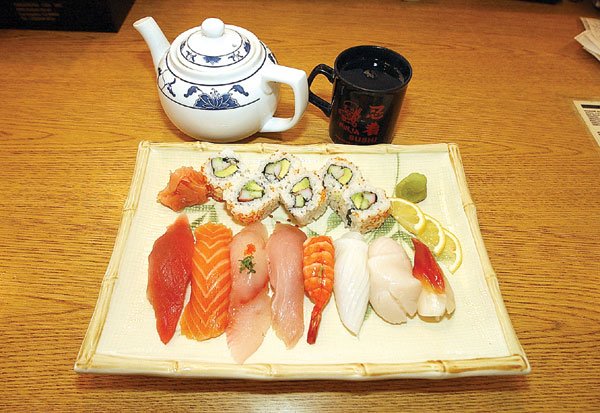Combining creativity, experimentation and culinary craft, the
skill of sushi preparation is an art whose following is devoted to
both the exquisite taste of incredibly fresh, raw foods and
delighted by the intricate display they encounter.
Combining creativity, experimentation and culinary craft, the skill of sushi preparation is an art whose following is devoted to both the exquisite taste of incredibly fresh, raw foods and delighted by the intricate display they encounter.
At Ninja Sushi in Gilroy, owners Chris and Kim Chung serve up recipes passed down for generations alongside current creative endeavors. With special attention to the details of presentation, the couple put the skills they learned as art students in college to use with food.
“Matching color is really important to creating a traditional dish,” said Chris. “But color and taste have to be a good combination. You can have every color matched, but if it tastes bad, no one’s going to want that roll.”
The Chungs order anywhere from 20 to 22 types of sushi-grade fish and seafood items per day for cutting by the sushi itamae, or chef, who may use up to
seven different knives on one fish in the course of boning, scaling and slicing. His domain is nearly sacred.
No waiters or waitresses may venture in or out of the itamae’s area while he is compiling the ingredients for a roll, washing his hands after each ingredient layer is laid on the table so as to not mix flavors, and being careful to handle the fish with spoons that have been resting in ice water so as to not expose the fish to any sort of heat source.
Sushi came into being during the Edo period in Japan, from 1603 to 1867, when the term came to mean any sort of fish pickled in vinegar, according to Japan-Guide.com. Today, sushi refers to a variety of dishes containing rice, sushi vinegar and other ingredients used to form a variety of traditional and modern shapes.
Some of the most popular in the South Valley are specialty rolls designed to be reminiscent of animals and nature scenes. The dragon roll includes eyes made of octopus, while a caterpillar roll includes markings made of avocado.
A rainbow roll incorporates fish of varying colors and the sunrise sushi combines tuna and fish eggs topped off with a quail egg that looks like a sun rising over the hills.
“You get an idea from (a book) and you make it your own,” said Kim. “You have to study to be current, and you have to try new things for yourself.”
The couple learned the art of sushi making from Kim’s sister and brother-in-law who have a Santa Cruz-based restaurant, but stay current on trends by frequently reading about sushi news from Japan.
In that country, daily competitions are held for sushi preparation, and the results are compiled into trade books that Chris and Kim take home about once every four to eight weeks. They glean ideas from these books and use them to translate sushi for a broader audience.
“You cannot make it without at least 10 or 20 different kinds,” said Kim. “You have to know what people like in a city, like they like the raw better in Santa Cruz and the cooked here, or people like it a little more spicy here.”
Sometimes after hours the staff will experiment with new ideas, taste-testing for themselves any new creation. Some of them get seemingly out of hand.
Chris’ special roll, for example, is a roll filled with crab, lobster salad, avocado and cucumber, then topped by yellowtail, fresh water eel, green onion, special sauce and tobiko, or fish eggs. It may sound like a kitchen-sink suggestion, but Chris’ special roll is now the couple’s top seller.
What are the different types of sushi?
Each sushi restaurant may have its own taste or style, but some of the basic forms remain the same no matter where sushi connoisseurs may go, according to Japan-Guide.com. Here are a few of the most common types:
Nigiri
Rice balls topped with fish or other ingredients such as eel, shrimp, octopus, squid and fried egg.
Gunkan
Seaweed and rice cups filled with seafood, most commonly fish eggs or sea urchin.
Norimaki
The sushi rolls that most Americans are familiar with – dried seaweed wrapped around sushi rice and seafood as well as other ingredients sometimes.
Temaki
Hand-rolled sushi cones filled with rice, vegetables and seafood.
Oshizushi
A pressed sushi formed in wooden boxes and very popular as ekiben, or Japanese box lunches.
Inari
Aburaage, or deep fried tofu bags, stuffed with rice to create a simple, inexpensive sushi.
If you’re considering making your own sushi at home, skip the pre-packaged fish section of the meat market and ask the butcher at the seafood counter if he or she has any “sushi grade” fish available. Generally this fish is fresher and has been stored with greater attention to sanitation since it is not intended for cooking, according to SushiFaq.com, a Web site offering answers and tips on preparing one of Japan’s most famous dishes.












